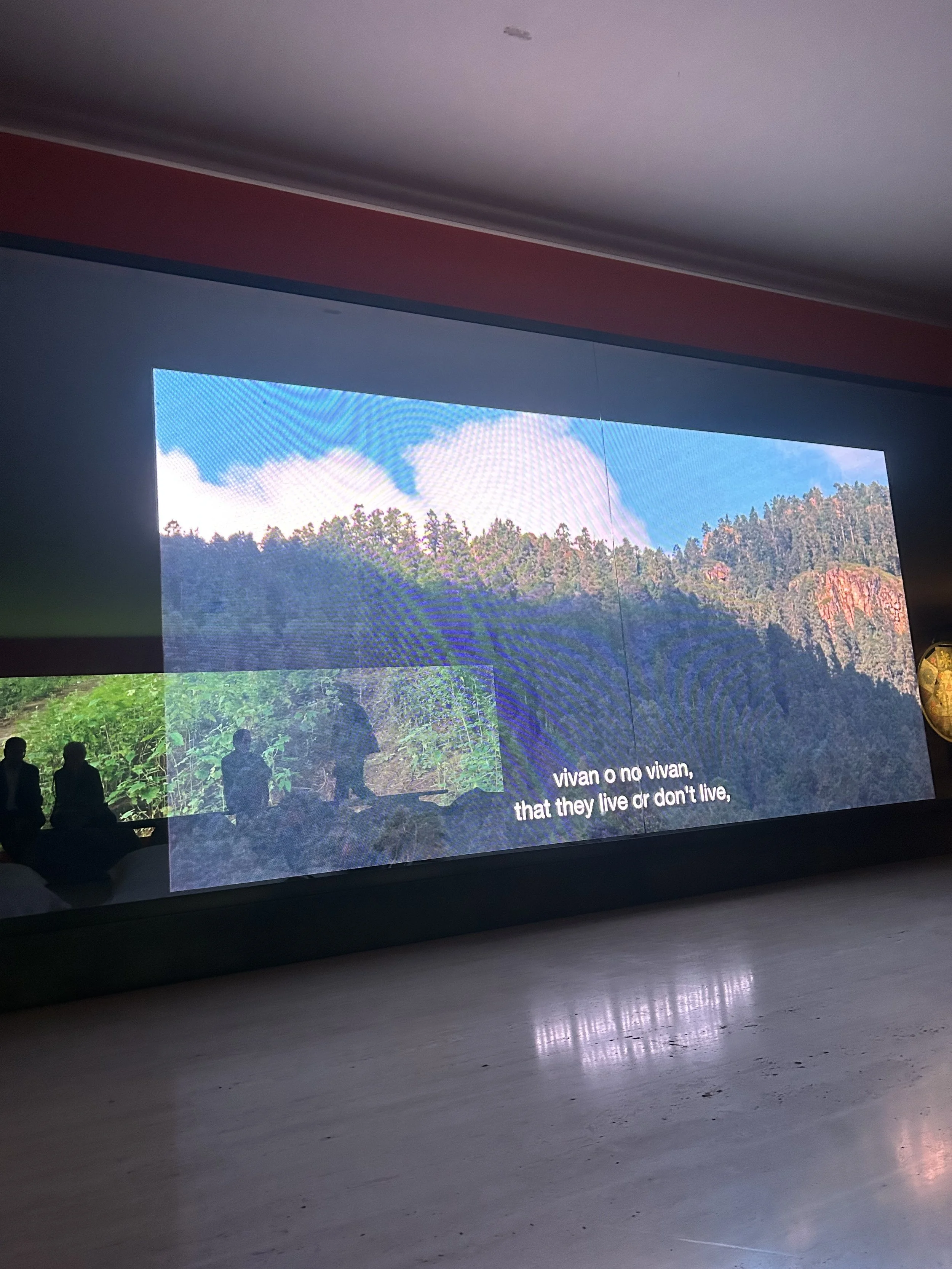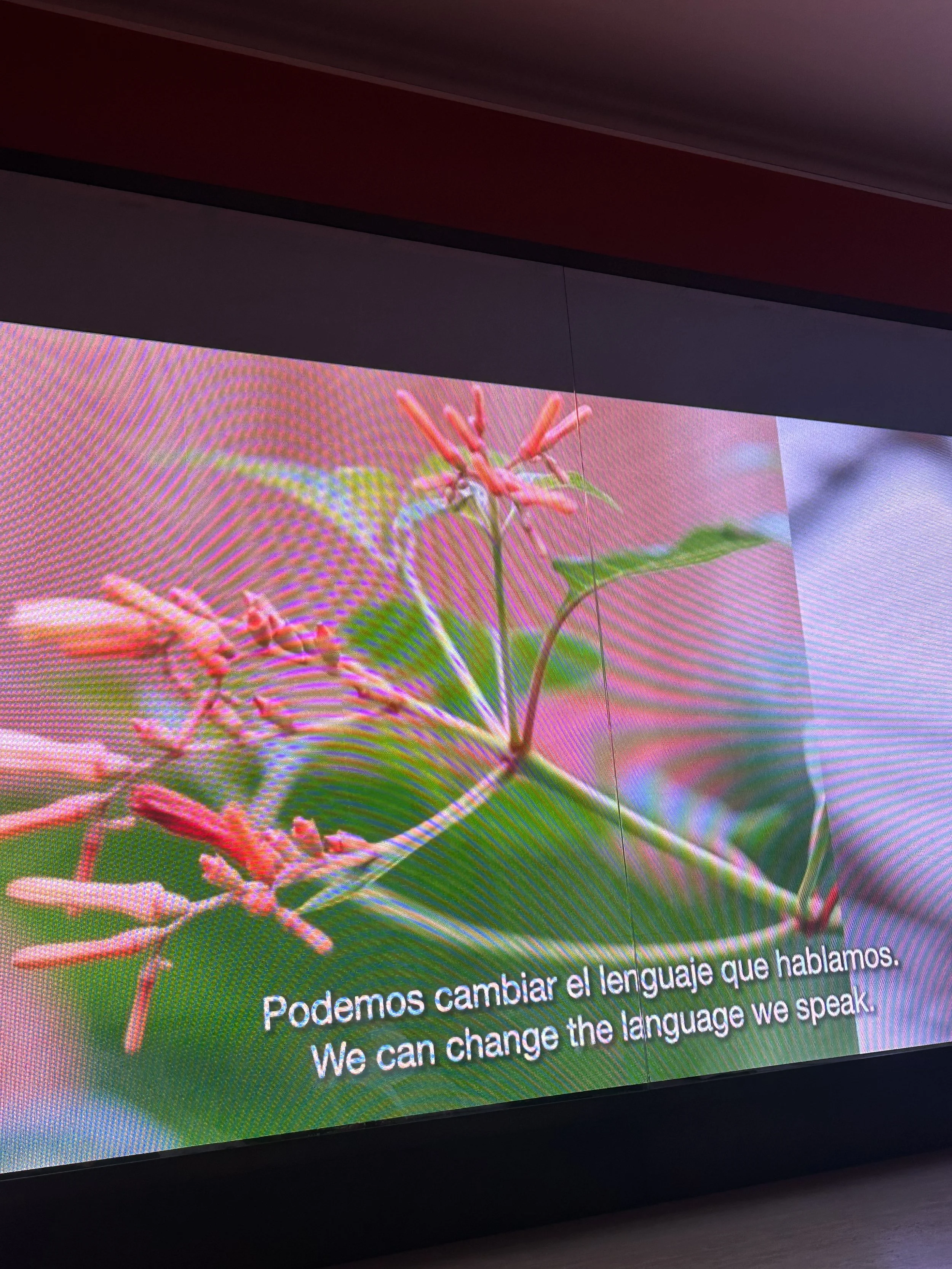Migration, Textiles, and Home: An Interview with Stephanie Comilang. Reflecting on Search for Life at the Thyssen Museum
Migration, Textiles, and Home: An Interview with Stephanie Comilang . Reflecting on Search for Life at the Thyssen Museum
COLECCIÓN MAG:
The first thing that came to mind when I heard you speak yesterday at the museum was how massive and difficult it is to address something as complex and long-standing as migration and colonization, and yet, you’ve found a symbolic and curious way to embrace it in your work. How did you arrive at that place?
STEPHANIE COMILANG:
I think it’s something I’ve always been thinking about, even if not in such a complex way initially. Growing up, I was constantly reflecting on ideas of home. Like I mentioned in the talk, my parents are immigrants from the Philippines, and being raised in that context really shaped my perspective.
Inside our home, everything felt Filipino, we spoke Tagalog, ate Filipino food, practiced cultural traditions. And outside, it was entirely different. So that duality really made me reflect on what "home" means, not just for me, but also for my parents.
The idea of home is interesting because it’s so fluid, constantly shifting. It's not fixed; it morphs over time and space. That fluidity has become a source of inspiration. I’ve always carried these questions with me, since childhood, through my teenage years, and now as an artist. I’ve never created work that doesn’t, in some way, deal with movement, migration, and the meaning of home. It’s something deeply embedded in my practice.
COLECCIÓN MAG:
And how does that connect with the visual language in your work: filming, music, garments? I read about the mantón you referenced, and you mentioned yesterday how it was used in Mexico too, right?
STEPHANIE COMILANG:
Yes! Since the exhibition is here in Madrid, I wanted it to have a strong connection to the city, to give people here a way into the work. The Mantón de Manila already carries that idea of something “from elsewhere.” With a little research, I discovered that versions of it existed in the Philippines even before Spanish colonization.
Originally, it was just a practical cloth, used for shade, to wipe sweat, or cover oneself. When the Spanish arrived, they turned it into a symbol of modesty and control, forcing women to cover up. Over time, the upper-class mestizas began commissioning Chinese artisans to embroider them with elaborate scenes, flowers, butterflies, and even oriental motifs that were fashionable in Europe at the time.
I saw some stunning examples from the 19th century here in Madrid at the Textile Museum, massive and incredibly intricate. And it's fascinating because the mantón still exists in places like Seville, worn in flamenco and other traditional events.
So for me, it became this perfect object to explore in the exhibition, both as a sculpture and within the film. In the film, a Mexican historian talks about the Manila Galleons, the rebozo, and how these textiles moved through the Philippines, Mexico, and Spain.
In the show, you see two veils, ghostly mantones made from piña fabric, a sheer textile made from pineapple fibers. Pineapples, originally from South America, were brought to the Philippines by the Spanish, where they took root and became a luxury textile. Ironically, piña fabric was also used by colonizers to control Filipino bodies, men were forced to wear sheer shirts so they couldn’t hide weapons.
Now, piña is used for formal wear, like barong tagalog shirts at weddings, but its history is layered with colonization and resistance. So, in my work, the butterfly, the fabric, the pearl, these aren’t just visuals. They’re deeply tied to ideas of home, migration, control, and adaptation.
COLECCIÓN MAG:
That makes so much sense. You also mentioned working with VR—how do you see this kind of immersive technology intersecting with your storytelling?
STEPHANIE COMILANG:
Technology is a huge part of my practice. As artists, we choose our tools, and for me, using what’s available technologically is exciting. I think a lot about camera perspective, how to film, what kind of devices to use, and how those tools affect storytelling.
Phones are interesting because they’re so intimate, we talk into them, we carry them everywhere. That personal connection becomes a storytelling tool. I’ve also used drones in my work, not just as cameras, but as characters.
In my film Paradise, about domestic workers in Hong Kong, the drone is a character—she’s voiced by my mom, actually—and her role is to interact with the women. Drones are usually associated with surveillance and war, but I wanted to flip that and create something more empathetic. I flew the drone low, close to eye level, to create a sense of companionship.
So I’m not interested in technology as dystopia, like in most sci-fi narratives. For me, it’s about connection, even spiritual connection. That’s something I touched on yesterday in the talk. In my work, technology is linked to care, emotion, and intimacy.
COLECCIÓN MAG:
Yes, yesterday you said something I really loved, that butterflies remember being caterpillars. That metaphor feels like such a beautiful entry point into spirituality in your work.
STEPHANIE COMILANG:
Exactly. I wouldn’t necessarily call it spirituality in the traditional sense, but there’s definitely a desire to connect with people on a deeper, emotional level.
I deal with serious topics: migration, displacement, power structures—but ultimately, what drives me is that emotional connection with the audience. I don’t always think about that consciously while I’m making the work, but I know it’s the heart of it.
So with VR, or any new technology, it’s about twisting it into something that helps connect people, rather than isolate them.
COLECCIÓN MAG:
I could honestly talk with you for hours, but here’s one last question: What did you grow up believing in—spiritually, culturally, emotionally?
STEPHANIE COMILANG:
I love that question. I grew up in a Roman Catholic family—very traditional. The Philippines is predominantly Catholic because of Spanish colonization. My parents were strict about it, but honestly, I never really felt connected to it.
Growing up in Canada, I quickly distanced myself from organized religion. What I did believe in, even as a kid, was creativity—being able to make things, express myself. I think I had an “artist mentality” from a really young age. I always knew I wanted to do this.
COLECCIÓN MAG:
And what about being a woman—how does that factor into your work or your experience in the art world?
STEPHANIE COMILANG:
That’s such a layered question. I didn’t grow up in the Philippines, but I’ve studied history. In pre-colonial times, there were women known as babaylan—they were shamans and spiritual leaders. They held central roles in politics, agriculture, and healing.
But when the Spanish arrived, those roles were erased—babaylan were turned into witches or villains because they didn’t align with Catholic ideals. Still, I feel that strong feminine energy is deeply rooted in Filipino culture.
As for the art world—honestly, it’s hard everywhere. Especially for women. One of the biggest issues is motherhood. There’s so little support for artists who want to have children. If you leave the system for a few years, it can really affect your career.
International shows often don’t accommodate childcare. If you can’t bring your kid, you can’t go. That means lost opportunities, lost connections. I don’t have kids, and that was a conscious choice. I knew I couldn’t have built the career I have now if I had taken that path earlier.
It’s a harsh reality—because men don’t face that same pressure. For many women, it feels like an either/or decision: either build your career, or step away and risk losing momentum. It shouldn’t be like that. There needs to be more structural support, like childcare at residencies or better funding options.
I think things are slowly changing, but it’s still really tough.
COLECCIÓN MAG:
Thank you for speaking so openly. It’s important to name these realities. I think our generation is really pushing for change.
STEPHANIE COMILANG:
Yes, absolutely. Just talking about it is a start. Thanks for having this conversation—it’s been great.
ARTIST BIO
Stephanie Comilang's parents immigrated from the Philippines to Canada in the 1970s to escape the political unrest of Ferdinand Marcos's dictatorship. Growing up in an immigrant household shaped her idea of home and has served as the starting point for much of her artwork. She graduated from the OCAD University in 2006 with a BFA in Integrated Media. IG: @stephaniecomilang




